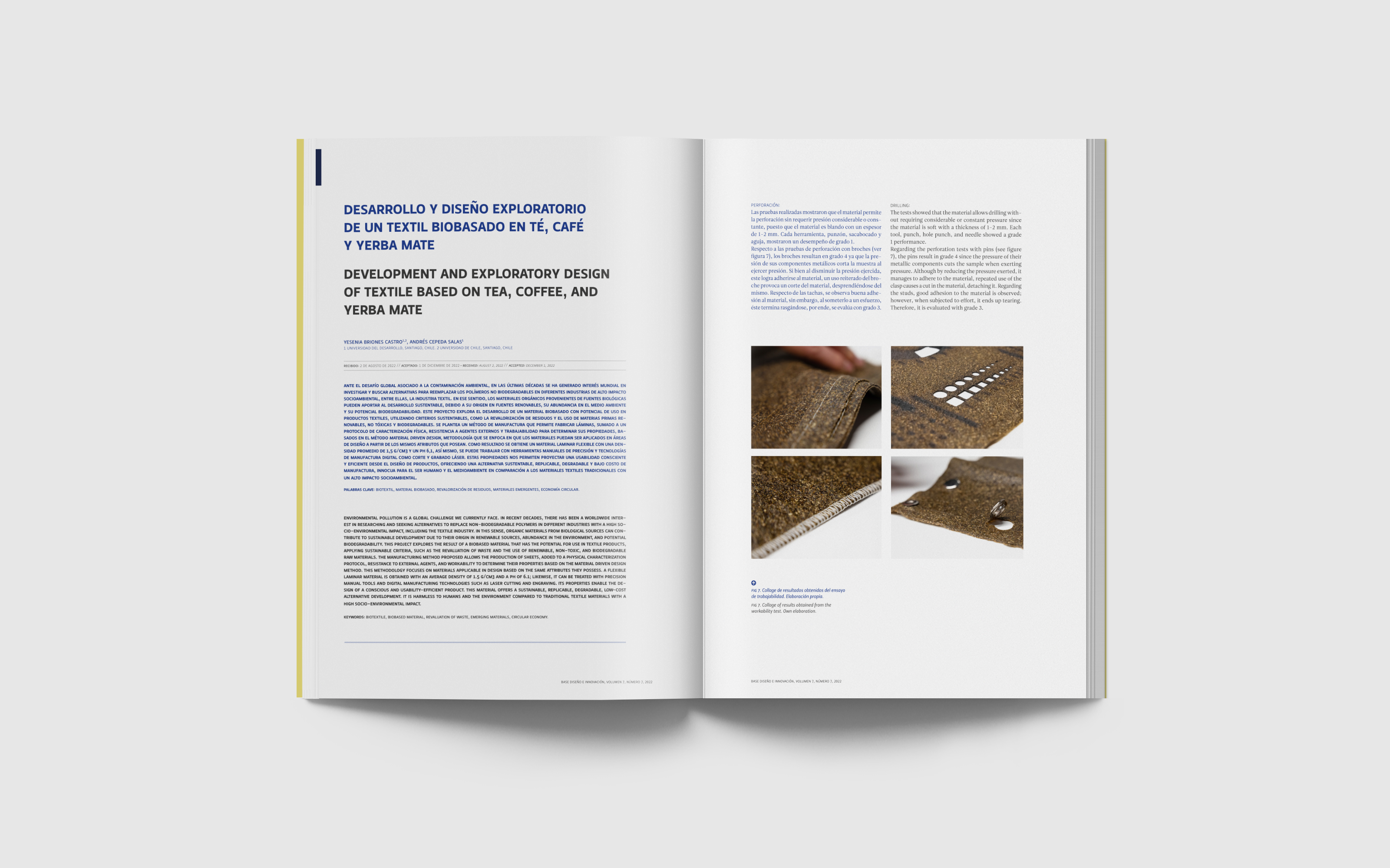Desarrollo y diseño exploratorio de un textil biobasado en té, café y yerba mate.
Contenido principal del artículo
Resumen
Ante el desafío global asociado a la contaminación ambiental, en las últimas décadas se ha generado interés mundial en investigar y buscar alternativas para reemplazar los polímeros no biodegradables en diferentes industrias de alto impacto ambiental, entre ellas la industria textil. En ese sentido, los materiales orgánicos provenientes de fuentes biológicas pueden aportar al desarrollo sustentable, debido a su origen en fuentes renovables, su abundancia en el medio ambiente y su potencial biodegradabilidad. Este proyecto explora el desarrollo de un material biobasado que tenga potencial de uso en productos textiles, utilizando criterios sustentables, como la revalorización de residuos y el uso de materias primas renovables y biodegradables. Se plantea un método de manufactura que permita fabricar láminas, sumado a un protocolo de caracterización física, resistencia a agentes externos y trabajabilidad para determinar sus propiedades, basados en el método de “Material driven design”, metodología que se enfoca en que los materiales puedan ser aplicados en áreas de diseño a partir de los mismos atributos que posean. Como resultado se obtiene un material laminar flexible con una densidad promedio de 1,5 g/cm3 y un pH 6,1, así mismo se puede trabajar con herramientas manuales de precisión y tecnologías de manufactura digital como corte y grabado láser. Estas propiedades nos permiten proyectar una usabilidad consciente y eficiente desde el diseño de productos, ofreciendo una alternativa sustentable, replicable, degradable y bajo costo de manufactura, innocua para el ser humano y el medioambiente en comparación a los materiales textiles tradicionales con un alto impacto ambiental.
Detalles del artículo
Citas
Ananas-anam (2017). Piñatex I #MadefromPiñatex. New materials for a new world. Retrieved July 22, 2022, from https://www.ananas-anam.com
Arévalo, K. (1996). Elaboración de plásticos biodegradables a partir de polisacáridos y su estudio de biodegradación a nivel de laboratorio y campo [Doctoral dissertation, Universidad Autónoma de Nuevo León]. http://eprints.uanl.mx/4767/
Beall, A. (2020, July 12). Fast fashion is leading to a mountain of clothing being thrown away each year and has a huge impact on the environment, so can we turn our unwanted garments into something useful? https://www.bbc.com/future/article/20200710-why-clothes-are-so-hard-to-recycle
Bhardwaj, V. & Fairhurst, A. (2010). Fast fashion: Response to changes in the fashion industry. The International Review of Retail, Distribution and Consumer Research, 20(1) 165-173, https://doi.org/10.1080/09593960903498300
Biolab FAU. [@biolabfau] (2016). Laboratorio de Materiales Biobasados FAU. Instagram. Retrieved July 22, 2022, from https://www.instagram.com/biolabfau/
Cladophora. Cladophora by Malu Lücking. Retrieved July 29, 2022, from https://maluluecking.pb.design/cladophora
Demicheli, M. (1996). Plásticos biodegradables a partir de fuentes renovables. The IPTS Report, 10(1), 1-10. https://app.vlex.com/#vid/120222
Di Bartolo, A., Infurna, G. & Dintcheva, N. (2021). A Review of Bioplastics and Their Adoption in the Circular Economy. Polymers, 13(8), 1229. MDPI AG. https://doi.org/10.3390/polym13081229
Fab Textiles (2019). Coffee BIO-Leather Bag | FabTextiles. Retrieved July 29, 2022 from http://fabtextiles.org/coffee-leather-bag/
Fablab U. de Chile. (2012). FABLAB Universidad de Chile. Retrieved July 22, 2022 from http://www.fablab.uchile.cl/
FabLab UC. (2016). Laboratorio de prototipado digital Fablab UC. Retrieved July 22, 2022 from http://fablabuc.herokuapp.com/nosotros
Giaccardi, E. & Karana, E. (2015). Foundations of Materials Experience: An Approach for HCI. In Proceedings of the 33rd Annual ACM Conference on Human Factors in Computing Systems, 2447–2456. https://doi.org/10.1145/2702123.2702337
Gutiérrez, Q. (2021, october 1). Las 9 R de la Economía Circular. Sostenibilidad. Sostenible o Sustentable. Retrieved July 22, 2022, from https://sostenibleosustentable.com/es/economia-verde/9-r-de-la-economia-circular/
Karana, E., Barati, B., Rognoli, V., & Zeeuw van der Laan, A. (2015). Material driven design (MDD): A method to design for material experiences. International journal of design, 9(2), 35-54. http://hdl.handle.net/11311/979536
LABVA. (2022). Somoslabva [Colaboraciones]. Instagram. Retrieved July 29, 2022 https://www.instagram.com/somoslabva/
Lee, B. et al. (2018). Gelation of an alginate film via spraying of calcium chloride droplets. Chemical Engineering Science 183: 1-12. https://doi.org/10.1016/j.ces.2018.02.049
MaterialDistrict (2015, August 2). Rotterdam fruit leather. Retrieved July 22, 2022, from https://materialdistrict.com/material/rotterdam-fruitleather/
MaterialDistrict (2021, June 9). Berriestex – vegan leather. Retrieved July 22, 2022, from https://materialdistrict.com/material/berriestex-vegan-leather/
Materiom. (2022). Materiom.org. We're growing the regenerative materials economy. Retrieved July 22, 2022, from https://materiom.org/
Medina, E. (2022). Biología, Diseño y Naturaleza. Biology Studio. Retrieved July 22, 2022, from https://biologystudio.com.mx/
Muniyasamy, S., Mohanrasu, K., & Gada, A., Mokhena, T. C., Mtibe, A., Boobalan, T., Paul, V., Arun, A. (2019). Biobased Biodegradable Polymers for Ecological Applications: A Move Towards Manufacturing Sustainable Biodegradable Plastic Products. In S. ul-Islam Integrating Green Chemistry and Sustainable Engineering, 215-253. https://doi.org/10.1002/9781119509868.ch8
Niinimäki, K., Peters, G., Dahlbo, H., Perry, P., Rissanen, T., & Gwilt, A. (2020). The environmental price of fast fashion. Nature Reviews Earth & Environment, 1, 12. 189-200. https://doi.org/10.1038/s43017-020-0039-9
Project Pomace. (2022). Retrieved July 29, 2022, from https://pomace.nl/about/
Spora Biotech. (2022). Mycelium Mushroom Leather - Sporatex. Spora Biotech Plataform. Retrieved July 29, 2022, from https://www.sporabiotech.com/
Rodríguez, N.; McLaughlin, M. & Pennock, D. (2019). La contaminación del suelo: una realidad oculta. Organización de las Naciones Unidas para la alimentación y la agricultura (FAO). Retrieved July 22, 2022, from https://www.fao.org/3/i9183es/i9183es.pdf


